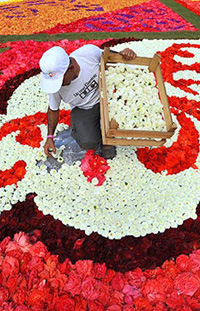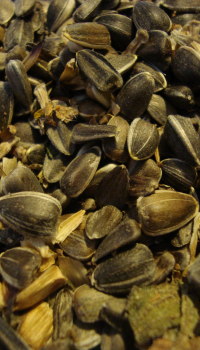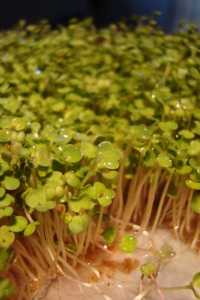
Amazing things you can do with 500,000 dahlias.
There are new White House kitchen garden videos.
Edible Geography has a day out with mushrooms grown in an old railway tunnel.

Amazing things you can do with 500,000 dahlias.
There are new White House kitchen garden videos.
Edible Geography has a day out with mushrooms grown in an old railway tunnel.
Inspired by Geoff Lawton’s Establishing a Food Forest, a group has got together to explore the potential of food forest gardening on the Kapiti Coast. Our vision is to build a community food forest garden for Kapiti.
Planned, planted and maintained by the community, the forest garden will serve as an education resource, plant nursery, seed bank, outdoor community centre, meeting point and food bank. Accessible to all, the area will become an edible landscape with walkways and glades, natural in look but designed with our needs for sustenance and play. A living repository for the future, in the heart of our community.
We’ve been doing a lot of talking, thinking, researching and come up with a document that we think encompasses the project’s heart. Now, we need some input and some support from you.
Have a read of the Kapiti Community Food Forest Proposal
Please do send us an email answering the following questions:
1. Do you support in principle the establishment of a community food forest in Kapiti?
2. Would you be willing to be part of a group of volunteers that is responsible for the establishment and maintenance of a Kapiti community food forest ?
3. Do you have any resources (land or money) you would be willing to donate to help to establish the Kapiti community food forest?
First in a series looking at wonderful world of food forests, or forest gardening.
A food forest, also called a forest garden, is a productive and organic garden modeled on the ecosystem of a forest. Species are selected to create a stable, functioning environment that fulfill the needs of the gardeners by producing fruits, berries, vegetables, herbs, seeds and other useful plant material.
Each plant performs many multiple roles within the system – promoting growth of other plants, inhibiting weeds, shelter, mulch, pest control, bird food, cross-pollination, attracting beneficial insects and of course providing food, medicine and utility plants for community use.
Food forests are:
– consciously designed using permaculture principles which mimic natural systems;
– multi-layered – trees and shrubs grow surrounded by a herbaceous layer, root crops, vines;
– perennial – plants grow every year without replanting;
– highly productive;
– biodiverse;
– beautiful;
– self-renewing;
– self-fertilising;
– once established, can be low-maintenance.
Well, I guess it is spring.
One of the things I love about this city is how green it is. Not the city city but the hills surrounding it – houses peaking out from amongst the trees, it looks incredible. Love it. And then there’s the Karori Wildlife Sanctuary and Otari Wilton Bush that are incredible conservation areas just 10 minutes from the city centre.
Anyway, the point of all this was to let you know about DOC’s Conservation Week, the Wellington Spring Festival including the tulip displays at the Botanic Gardens. Wellington Botanic Society are exploring the mysteries of lancewood at their September talk (despite two years of trying, I haven’t made it to a single event of their’s…I will keep trying).
And don’t forget Seedy Sunday in Kapiti on September 20. A chance to swap your seeds, plants and produce and learn a little about gardening and about your local community. Brooklyn Transition Towns also have a seed swap that day.

This month, Dave Johnston will be talking to us about Effective Microorganisms (EM). The concept of EM was developed by Japanese horticulturist Teruo Higa, from Japan. He reported in the 1970s that a combination of approximately 80 different microorganisms is capable of positively influencing decomposing organic matter such that it reverts into a ‘life promoting’ process. So essentially, we are talking about putting life back into our soil and growing healthier, nutrient-dense food.
The swap table has been huge! It’s fantastic to see such a variety of plants being grown in the area. Bring along any of seeds, produce or plants you have to swap.
This month, you may want to remember to bring some cash as there will also be a bit more of a sales table with books from Levin Soil & Health, Earth Whisperers/Papatuanuku DVDs, some Bokashi buckets and other EM.
I have to say a huge thanks Pat at the Kapiti Community Centre for looking after us so well. We are so lucky to have such great facilities available here. I’ve also been very grateful for the support of the Kapiti Observer, Levin Soil & Health, Sam, Andrew, Jo, Sharon, Pam and Richard, as well as you all for making Seedy Sunday such a great event. Let’s do it all again this Sunday!

One thing that keeps me happy over winter are my bonsai rocket gardens. Leaving the house for work when it’s dark and getting home in the some disposition, doesn’t allow time for garden therapy. So I’ve been bringing it inside. I spread them on to paper towels on an ice cream container lid, sprinkle water over it once a day and here in winter it usually takes 4 – 6 days to have yumminess. Then I just use them in everything.
High in nutrients and vitamins A, B, C and E, rocket (Eruca spp.) rocks over winter. The sprouts add a nice bit of warmth to any vegetable dish. I use them as a side vegetable for just about anything, sprinkle them on my tomato soup, add them to cheese sandwiches.

See the rest of this incredible photo article at Dark Roasted Blend